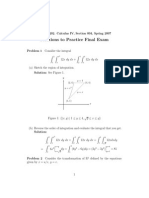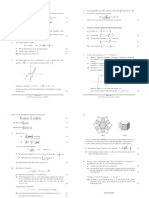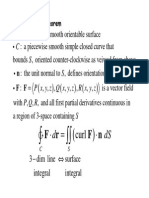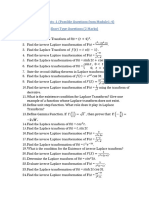MT261 Tutorial 3
Uploaded by
Gilbert FuriaMT261 Tutorial 3
Uploaded by
Gilbert FuriaMT 261
SEM I 2007/2008
DEPARTMENT OF MATHEMATICS MT 261: Several Variables Calculus for Non-Majors Tutorial sheet 3
1. Find the directional derivatives of f at P in the direction of a, where (i) f = x2 y 2 , (iii) f = xyz, P : (2, 3), P : (1, 1, 3), a=i+j (ii) f = 2x + 3y, P : (0, 2), a = 3j
a = i 2j + 2k
2. Find curlv where, with respect to the right-handed Cartesian coordinates, (i) v = xi + yzj (x2 + +z 2 )k (iii) v = y 2 i + z 2 j + x2 k. 3. Prove that (a) (F + G) = (b) (F G) = F G + G F where F and G are dierentiable scalars functions of x, y and z 4. Find (a) = ln |r| (b) = 1 r if F+ G (ii) v = (xi + yj + zk)(x2 + y 2 + z 2 )3/2
5. Let (x, y, z) and (x+x, y +y, z +z) be the temperatures at two neighbouring points P (x, y, z) and Q(x + x, y + y, z + z) of a certain region.
MT 261
SEM I 2007/2008
(a) Interpret physically the quantity Q(x + x, y + y, z + z) Q(x, y, z) = s s (b) Evaluate d = s0 s ds lim (c) Show that d = ds 6. If A = x2 zi 2y 3 z 2 j + xy 2 zA nd the divergence of A that is, 7. If A = x2 yi 2xzj + 2yzk nd curl curlA that is, ( A). A at the point (1, 1, 1) dr ds
8. Determine the constant a so that the vector V = (x + 3y)i + (y 2z)j + (x + az)k is solenoidal. 9. Evaluate the following iterated integrals. (a)
1 0 0 3
x4 dydx (b)
2 1 0 x1
ydydx (b)
4
2 cos
rdrd
2
MT 261
SEM I 2007/2008 F dS where F = 2yj + zk
10. Evaluate
and S is the surface x2 + y 2 = 4 in the rst two octants bounded by the planes z = 0, z = 5 and y = 0. 11. Using Greens theorem evaluate the line integral the boundary C of the region D where (a) F = (x2 ey , y 2 ex ), C the rectangle with vertices (0, 0), (2, 0), (2, 3), (0, 3) (b) F = (3y 2 , x y 4 ), D the square with vertices (1, 1), (1, 1), (1, 1), (1, 1) (c) F = (y, x), C the circle x2 +y 2 = 1/4 (d) F = (2xy 3 , 3x2 y 2 ), C : x4 +y 4 = 1.
S C
F (r).dr counter clockwise around
12. Using the divergence theorem evaluate the surface integral lowing data:
F.ndA for the fol-
(a) F = (x2 , 0, z 2 ), S the surface of the box |x| 1, |y| 3, |z| 2 (b) F = (ex , ey , ez ), S the surface of the cube |x| 1, |y| 1, |z| 1 (c) F = (cos y, sin x, sin z), S the surface of (x2 + y 2 ) 9, 0 z 2. (a) Evaluate the line integral 4xydx + (2x2 3xy)dy
C
if the curve C consists of the line segment from (3, 2) to (1, 0) and the rst quadrant arc of the circle x2 + y 2 = 1 from (1, 0) to (0, 1), traversed in the counterclockwise direction. (b) Evaluate the line integral 3xdx + 2xydy + zdz
C
if C is the circular helix dened by the parametric equations x = cos t, y = sin t, z = t ; 13. Evaluate the triple integrals 0 t 2.
MT 261 (a) (b)
SEM I 2007/2008
2 0 1 0 x 0 0 x+y 0 1x 0
ex (y + 2z)dzdydx. x sin ydzdydx.
14. Evaluate (x 2y + z)dS
S
with (a) S : z = 4 x, 0 x 4, 0 y 4 (b) S : z = 10 2x + 2y, 0 x 2, 0 y 4 15. Use Greens Theorem to evaluate the line integral y 2 dx + 4xydy
C
where C is the closed curve consisting of the arc of the parabola y = x2 from the origin to the point (2, 4) and the line segment from (2, 4) to the origin. 16. Verify Greens theorem by evaluating both integrals xey dx + ex dy =
C R
M N )dA x y
where C is the boundary of the region bounded by the graph of y = x and y = x3 . 17. Use the Gauss divergence theorem to evaluate the surface integral F ndA
S
with F = xy 2 i+x2 yj+yk and S is the surface of the cylinder x2 +y 2 = 1, 1 z 1. 18. Let Q be the solid region bounded by the coordinate planes and the plane 2x + 2y + z = 6 and let F = xi + y 2 j + zk. Find F ndS
S
where S is the surface of Q.
*******************************************************************
You might also like
- Vector Calculus - Solutions 1: 1. in Each Case, S Is The Shaded Region, Excluding Any Hatched Lines/curves. (A) (B)No ratings yetVector Calculus - Solutions 1: 1. in Each Case, S Is The Shaded Region, Excluding Any Hatched Lines/curves. (A) (B)7 pages
- 62-215 Practice Questions From Chapter 16 Winter 2013No ratings yet62-215 Practice Questions From Chapter 16 Winter 20131 page
- Attempt Remaining Six Questions. 1. (CT) Prove That.:.-20No ratings yetAttempt Remaining Six Questions. 1. (CT) Prove That.:.-202 pages
- National Institute of Technology Calicut Department of Mathematics MA 1001D: Mathematics 1No ratings yetNational Institute of Technology Calicut Department of Mathematics MA 1001D: Mathematics 12 pages
- 18 MAB 102 T Advanced Calculus and Complex Analysis-Assignment-2 PDFNo ratings yet18 MAB 102 T Advanced Calculus and Complex Analysis-Assignment-2 PDF3 pages
- Ma2261 Mathematics Ii UNIT I - Ordinary Differential EquationNo ratings yetMa2261 Mathematics Ii UNIT I - Ordinary Differential Equation17 pages
- Department of Mathematics, IIT Kharagpur MA10002: Mathematics-II Assignment-2 On Integral CalculusNo ratings yetDepartment of Mathematics, IIT Kharagpur MA10002: Mathematics-II Assignment-2 On Integral Calculus1 page
- Analytic Geometry: Graphic Solutions Using Matlab LanguageFrom EverandAnalytic Geometry: Graphic Solutions Using Matlab LanguageNo ratings yet
- 13th February 2017 - Air Standard Cycles and Their AnalysisNo ratings yet13th February 2017 - Air Standard Cycles and Their Analysis25 pages
- Comparisons Between Supercritical & Sub Critical Thermal Power Plant NEW1No ratings yetComparisons Between Supercritical & Sub Critical Thermal Power Plant NEW139 pages
- Microscopios CX31RBSF, CX31LBSF Despiece PDF100% (1)Microscopios CX31RBSF, CX31LBSF Despiece PDF14 pages
- UPS-Uninterruptable Power Supplies - Electronic Circuits and Diagrams-Electronic Projects and DesignNo ratings yetUPS-Uninterruptable Power Supplies - Electronic Circuits and Diagrams-Electronic Projects and Design4 pages
- Organic Chemistry II - Chem 2262 - DR Spivak Si PortfolioNo ratings yetOrganic Chemistry II - Chem 2262 - DR Spivak Si Portfolio27 pages
- 3 - (M) Discrete Random Variables & Probability Distributions100% (1)3 - (M) Discrete Random Variables & Probability Distributions58 pages
- Simultaneous Optimization of Pump and Cooler Networks in A Cooling Water SystemNo ratings yetSimultaneous Optimization of Pump and Cooler Networks in A Cooling Water System9 pages
- Cation Exchange Resin DUOLITE C20 PDS PDFNo ratings yetCation Exchange Resin DUOLITE C20 PDS PDF4 pages
- Vector Calculus - Solutions 1: 1. in Each Case, S Is The Shaded Region, Excluding Any Hatched Lines/curves. (A) (B)Vector Calculus - Solutions 1: 1. in Each Case, S Is The Shaded Region, Excluding Any Hatched Lines/curves. (A) (B)
- 62-215 Practice Questions From Chapter 16 Winter 201362-215 Practice Questions From Chapter 16 Winter 2013
- Attempt Remaining Six Questions. 1. (CT) Prove That.:.-20Attempt Remaining Six Questions. 1. (CT) Prove That.:.-20
- National Institute of Technology Calicut Department of Mathematics MA 1001D: Mathematics 1National Institute of Technology Calicut Department of Mathematics MA 1001D: Mathematics 1
- 18 MAB 102 T Advanced Calculus and Complex Analysis-Assignment-2 PDF18 MAB 102 T Advanced Calculus and Complex Analysis-Assignment-2 PDF
- Ma2261 Mathematics Ii UNIT I - Ordinary Differential EquationMa2261 Mathematics Ii UNIT I - Ordinary Differential Equation
- Department of Mathematics, IIT Kharagpur MA10002: Mathematics-II Assignment-2 On Integral CalculusDepartment of Mathematics, IIT Kharagpur MA10002: Mathematics-II Assignment-2 On Integral Calculus
- Analytic Geometry: Graphic Solutions Using Matlab LanguageFrom EverandAnalytic Geometry: Graphic Solutions Using Matlab Language
- Computer Solved: Nonlinear Differential EquationsFrom EverandComputer Solved: Nonlinear Differential Equations
- Transformation of Axes (Geometry) Mathematics Question BankFrom EverandTransformation of Axes (Geometry) Mathematics Question Bank
- 13th February 2017 - Air Standard Cycles and Their Analysis13th February 2017 - Air Standard Cycles and Their Analysis
- Comparisons Between Supercritical & Sub Critical Thermal Power Plant NEW1Comparisons Between Supercritical & Sub Critical Thermal Power Plant NEW1
- UPS-Uninterruptable Power Supplies - Electronic Circuits and Diagrams-Electronic Projects and DesignUPS-Uninterruptable Power Supplies - Electronic Circuits and Diagrams-Electronic Projects and Design
- Organic Chemistry II - Chem 2262 - DR Spivak Si PortfolioOrganic Chemistry II - Chem 2262 - DR Spivak Si Portfolio
- 3 - (M) Discrete Random Variables & Probability Distributions3 - (M) Discrete Random Variables & Probability Distributions
- Simultaneous Optimization of Pump and Cooler Networks in A Cooling Water SystemSimultaneous Optimization of Pump and Cooler Networks in A Cooling Water System

























































































